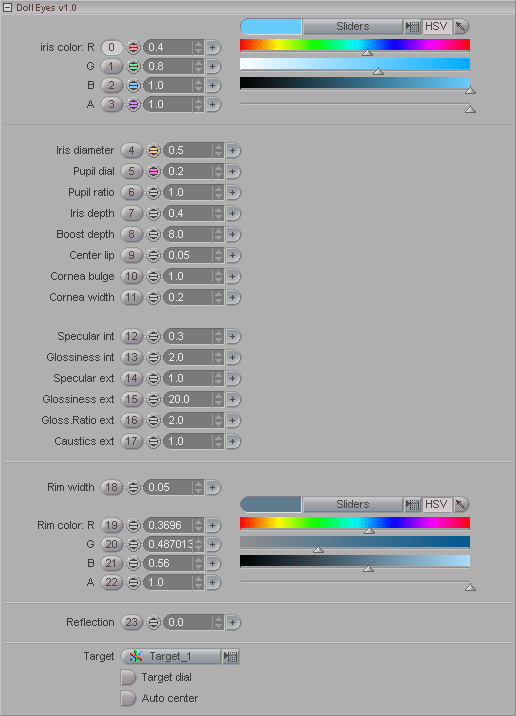|
|
|---|
 Scary, isn't it?
Well, a lot of the controls should be pretty self
explanatory, such as Iris Color,
Iris Diameter, etc. Some might not
be so obvious, but when you try them they'll start to make sense.
For example, the Specular and Glossy section has controls for
the Int (interior) and Ext
(exterior) of the eye.
Scary, isn't it?
Well, a lot of the controls should be pretty self
explanatory, such as Iris Color,
Iris Diameter, etc. Some might not
be so obvious, but when you try them they'll start to make sense.
For example, the Specular and Glossy section has controls for
the Int (interior) and Ext
(exterior) of the eye.
By the way, this shader gets applied to a basic sphere; you don't need to do any modeling. If you look at the sample scenes and deactivate the inputs to the material, you'll see that they're just spheres.
Important: The output of the DollEyes shader should be connected to the Radiance input of the material.
At the bottom of the block you'll see the target controls. Since this is a shader, you need to be able to animate the direction of the eyes, because the rotation of the eye objects will not actually "move" the eyes. To move the eyes, choose a Target from the pulldown.
Target Dial: When this is on, the pupil's dilation will be controlled by the X scale of the Target object.
Auto Center: Use this to center the iris when the geometry for the eye is not a perfect sphere.
We've included a few scenes to give you an idea of how this all works, and provide you with something to play with. The scenes are in the messiah_content\Scenes\Samples folder. The scene are:
DollEyes_Shader_Sample.fxs - This is just a basic eye setup. You can render different frames to see what it looks like from different angles. (The eyes are targeted to a null that is moving.)
DollEyes_Shader_Sample_Textured_A.fxs - This version uses a Gradient and Noisette to add some color to the iris.
DollEyes_Shader_Sample_Textured_B.fxs - This version adds on to version A by adding additional shader nodes, such as the BasicShader and another Gradient.